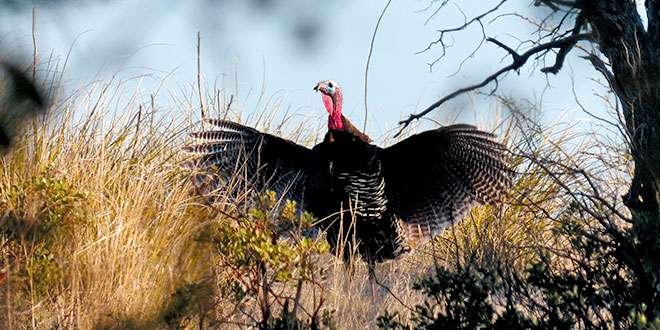Gould’s wild turkey in New Mexico
The wild turkey is a popular game bird throughout the United States, with their excellent eyesight and cautious behavior making for a challenging hunt. The excitement of calling in a tom or hearing the first gobble of the morning will create a lifelong memory.
Turkey hunting wasn’t always an attainable pursuit.
Wild turkey numbers dwindled throughout the early 20th century due to over-hunting and poor timber harvest practices, but with the establishment of wildlife hunting regulations, improved habitat management practices and trap-and-transplant efforts, turkey populations have increased substantially.
Habitat management was critical to the recovery of wild turkeys due to their dependence on large trees for roosting, wooded areas for escape cover and mesic open areas for brood-rearing habitat.
There are six subspecies of wild turkey, and New Mexico is home to three: Merriam’s, Rio Grande and Gould’s.
The Merriam’s turkey is the most abundant subspecies, found in most mountain ranges in New Mexico. Rio Grande turkeys are common in several of the state’s river valleys.
The Gould’s turkey, however, is of particular conservation interest to the New Mexico Department of Game and Fish. The majority of its range is in Mexico, but it does extend into southern Arizona and New Mexico.
The Gould’s can be distinguished from other subspecies by its size – it’s the largest subspecies in North America – and the white tips on its tail feathers and tail rump coverts.
Preferred habitat types for this species are pine-oak forested canyons into adjacent piñyon-juniper grassland slopes and cottonwood-sycamore riparian habitats.
In New Mexico, the Gould’s inhabits southern Hidalgo County and occupies major canyons and adjacent foothills in the Peloncillo, Animas and San Luis Mountains, as well as along drainages leading into the middle Animas Valley.
The Gould’s turkey was first documented in New Mexico in 1892, after which there were limited records of sightings until the 1980s. A lack of information on the subspecies and its limited habitat range resulted in it being listed as State Threatened in 1975 under the New Mexico Wildlife Conservation Act.
In 1982, researchers at New Mexico State University began gathering information on population status, life history requirements and habitat use. Based on the research, population estimates of Gould’s turkeys in the Peloncillo Mountains ranged from 12 to 75 birds in the 1980s and ’90s.
Less is known about their status in the Animas and San Luis Mountains because the areas are mostly private property, but a Game and Fish contractor surveyed these ranges about 20 years ago and estimated the population to be 50 to 100 birds within both ranges.
Following the university’s research, Game and Fish personnel began annual spring surveys in the Peloncillo Mountains to monitor population trends and determine a minimum population estimate.
Starting in 2006, surveyors began documenting roost use, recording the number of birds encountered and categorizing birds according to age and sex. The number of Gould’s detected during the survey has increased from 18 in 2006 to 95 in 2016.
The increase was supported by a translocation of turkeys when New Mexico, in an agreement with the Arizona Game and Fish Department, traded 40 pronghorn antelope for 60 Gould’s turkeys.
The 60 turkeys were moved from southeastern Arizona to the Peloncillo Mountains between 2014 and 2016, 27 of which were fitted with radio-backpacks. With this technology, researchers can monitor the turkeys and the data is providing information on dispersal and mortality rates.
Small turkey populations may be vulnerable to inbreeding and genetic drift, which can make them more susceptible to disease and may decrease their biological fitness. Increasing genetic diversity is important so populations are better able to survive future changes to climate, habitat and disease. Transplants provide wildlife biologists the opportunity to boost population numbers while enhancing genetic diversity.
Through population monitoring, habitat improvement and population augmentation, Game and Fish biologists were able to justify a limited hunt of Gould’s turkeys. Two licenses are offered annually, one as a raffle and one as an auction. Proceeds generated from the sale of the licenses fund habitat improvement projects and research efforts for the species.
One such project, in collaboration with funds from the National Wild Turkey Federation and U.S. Forest Service, involved reducing fuel loads around known turkey roost sites. This project reduced the risk of habitat loss due to wildfire and improved access to roost trees.
The goal to downlist Gould’s turkeys can best be accomplished by identifying and implementing a recovery strategy along with strong collaborations with federal agencies, nonprofit organizations and the public.
Habitat – areas in New Mexico offering the necessities for this bird to thrive – is limited, but with proper management biologists believe a stable population can be achieved.
For more information regarding the hunting of New Mexico’s wild turkeys, see the NMDGF wild turkey page.
For more about the limited hunt of Gould’s turkeys (two licenses offered annually, one as a raffle and one as an auction), see NMDGF’s Enhancement Licenses hunting page.
 New Mexico Wildlife magazine Conserving New Mexico's Wildlife for Future Generations
New Mexico Wildlife magazine Conserving New Mexico's Wildlife for Future Generations
